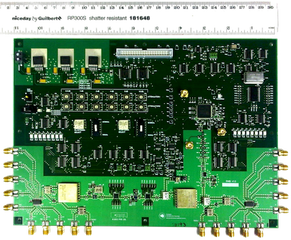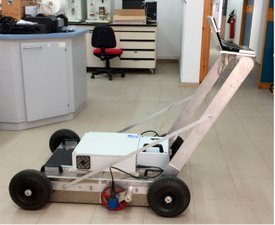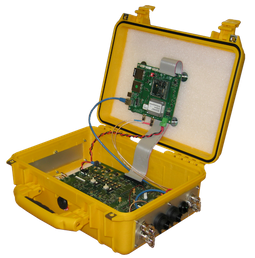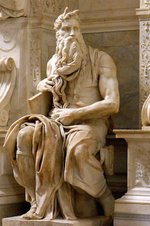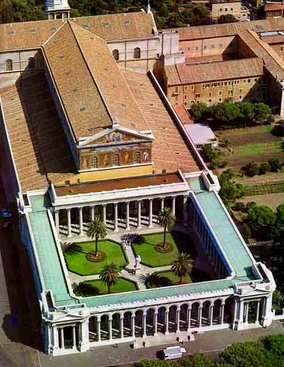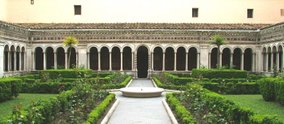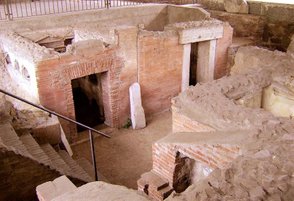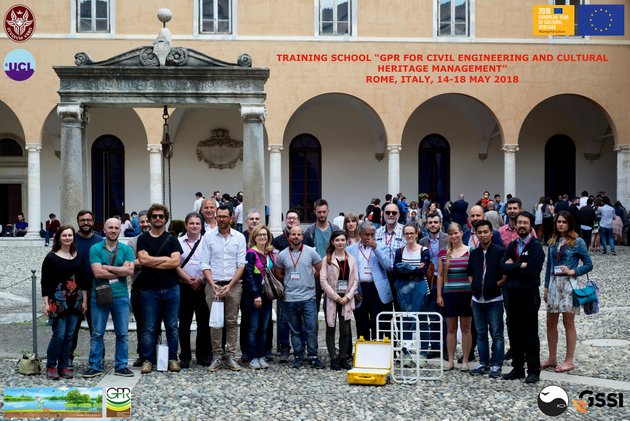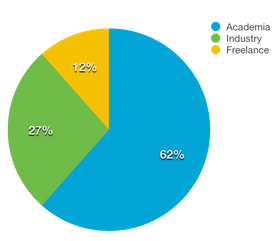TU1208 GPR Association
International non-profit network on Ground Penetrating Radar
Cooperation - Sharing - Open science - Excellence - Embracing diversity - Inclusiveness - Innovation - Bottom up
Founded in September 2017 as a follow up initiative of COST Action TU1208
Training School on Ground Penetrating Radar for civil engineering and cultural heritage management
Roma, Italy, May 14-18, 2018
TU1208 GPR Association, Associazione Italiana del Georadar, Sapienza University of Rome and University College London organised a Training School on "Ground Penetrating Radar for civil engineering and cultural heritage management." The course was successfully held in Italy, in the Engineering campus of Sapienza University of Rome (San Pietro in Vincoli), on 14-18 May 2018.
The Training School was targeted to civil and electronic engineers, archaeologists, geologists, geophysicists, early-career investigators and PhD/Masters students interested in Ground Penetrating Radar (GPR) technology and methodology, and particularly in the use GPR for civil-engineering investigations, archaeological prospection and cultural heritage preservation. Theoretical and practical sessions took place. During the school, we promoted debate and raised awareness about the importance and value of cultural heritage. We also discussed how to foster and facilitate engagement of GPR scientists with citizens and stakeholders.
Networking programmes and funding Institutions
The Training School was funded by TU1208 GPR Association, Associazione Italiana del Georadar, Sapienza University of Rome (in the framework of the "Conferences, Seminars and Workshops" programme) and University College London (in the framework of the "Rome Regional Engagement" programme).
European Year of Cultural Hertage
The Training School was awarded with the European Year of Cultural Heritage label. The aim of the European Year of Cultural Heritage 2018 is to encourage more people to discover and engage with Europe's cultural heritage, and to reinforce a sense of belonging to a common European space.
Cultural heritage shapes our identities and everyday lives. It surrounds us in Europe's towns and cities, natural landscapes and archaeological sites. It is not only found in literature, art and objects, but also in the crafts we learn from our ancestors, the stories we tell to our children, the food we enjoy in company and the films we watch and recognise ourselves in.
Heritage comes ‘from the past’ but is not static: it actually evolves though our engagement with it.
Our heritage is important to preserve and pass on to future generations. Through cherishing our cultural heritage, we can discover our diversity and start an inter-cultural conversation about what we have in common.
Coordinators of the School
- Prof. Lara Pajewski (Department of Information Engineering, Electronics and Telecommunications, Sapienza University of Rome, Rome, Italy)
- Dr Raffaele Persico (Institute for Archaeological and Monumental Heritage of the National Research Council, IBAM-CNR, Lecce, Italy)
- Dr Lai Bun Lok (University College of London, London, United Kingdom)
Trainers of the School
Lectures were given by 15 Trainers from 6 Countries, coming from Universities, Research Centres, Companies, and Public Agencies.
- Dr Michael Arvanitis (Geophysical Survey Systems, Inc - GSSI, US)
- Dr Pier Matteo Barone (American Universtiy of Rome, Rome, Italy)
- Dr Davide Comite (Department of Information Engineering, Electronics and Telecommunications, Sapienza University of Rome, Rome, Italy)
- Dr Francesco La Vigna (Municipality of Rome, Geology and Environmental Hydrogeology Office, Italy)
- Dr Lai Bun Lok (University College of London, London, United Kingdom)
- Prof. Lara Pajewski (Department of Information Engineering, Electronics and Telecommunications, Sapienza University of Rome, Rome, Italy)
- Dr Raffaele Persico (Institute for Archaeological and Monumental Heritage of the National Research Council, IBAM-CNR, Lecce, Italy)
- Dr Salvatore Piro (Institute for Technologies Applied to Cultural Heritage of the National Research Council, ITABC-CNR, Rome, Italy)
- Prof. Dragan Poljak (Faculty of Electrical Engineering, Mechanical Engineering and Naval Architecture - FESB, University of Split, Split, Croatia)
- Mr Maurizio Porcu (Codevintec Italiana srl, Milano, Italy)
- Prof. Aleksandar Ristic (Faculty of Technical Sciences of the University of Novi Sad, Novi Sad, Serbia)
- Dr Maja Škiljo (Faculty of Electrical Engineering, Mechanical Engineering and Naval Architecture - FESB, University of Split, Split, Croatia)
- Dr Francesco Soldovieri (Institute for Electromagnetic Sensing of the Environment of the National Research Council, IREA-CNR, Naples, Italy)
- Ms Anna Šušnjara (Faculty of Electrical Engineering, Mechanical Engineering and Naval Architecture - FESB, University of Split, Split, Croatia)
- Dr Carl Van Geem (Belgian Road Research Centre, BRRC, Bruxelles, Belgium).
Equipment
During practical sessions, we used an innovative stepped-frequency reconfigurable GPR prototype developed at the Italian National Research Council and within COST Action TU1208. Moreover, we used cutting-edge pulsed GPR systems manufactured by Geophysical Survey Systems, Inc - GSSI. The school organisers would like to thank GSSI for participating in this Training School and providing equipment.
Detailled list of equipment used during practical sessions:
- Reconfigurable stepped-frequency GPR prototype developed in Italy, covering the 50 - 1000 MHz frequency range. The original version of this prototype was implemented by the Institute for Archaeological and Monumental Heritage of the National Research Council (IBAM-CNR), in cooperation with the University of Florence and the Italian company Florence Engineering, within the research project AITECH funded by Regione Puglia; in the framework of COST Action TU1208, the prototype was significantly improved and widely tested in Italy, Malta and Norway.
- 1 x GSSI UtilityScan LT with 350 MHz antenna.
- 1 x GSSI StructureScan Mini XT with 2700 MHz antenna.
- 1 x SIR-4000 with 400 MHz antenna and external odometer.
Additional prototypes were presented and showcased on Monday (but not used during practical sessions). These include: two innovative Frequency Modulated Continuous Wave (FMCW) prototypes developed at University College London (namely, a low power 200-400 MHz FMCW GPR with bowtie antennas and a 30 MHz FMCW GPR with folded dipole antennas), and an affordable FMCW prototype developed at the University of Split for training purposes.
Class Scheduling
Monday, 14 May 2018 - Introduction to Ground Penetrating Radar technology, methodology, and applications. Innovative GPR systems.
Morning lectures: Building "B", 2nd floor, Reading Room ("Sala lettura")
Afternoon lectures: Room with Frescoes, at the cloister
Time | Trainer | Activity |
08:30 - 09:00 | Registration. | |
09:00 - 09:40 | L. Pajewski F. Mussgnug | Opening Session, Part 1 - Welcome words from the organizing institutions - A brief introduction to Sapienza University of Rome, to the "Conferences, Seminars and Workshops" programme, and to the Training School. - Download the slides of this presentation - A brief introduction to University College London and the "Rome Regional Engagement" programme. Full information on this programme can be found here: https://multidisciplinaryrome.org/ - A brief introduction to TU1208 GPR Association and Associazione Italiana del Georadar: objectives, priorities, activities and further information on the associations. |
09:40 - 10:10 | All | Opening Session, Part 2 - Getting to Know Each Other round: Trainees & Trainers briefly introduce themselves - Expectations round: Trainees & Trainers briefly explain what they expect from the school |
10:10 - 11:00 | L. Pajewski | GPR basic principles, capabilities and limits. GPR applications. Choice of GPR equipment for different applications. |
11:00 - 11:30 | Cappuccino & Cornetto Break | |
11:30 - 13:00 | R. Persico | Reconfigurable stepped-frequency GPR prototype for civil-engineering and archaeological prospection, developed at the National Research Council of Italy. Examples of application and case studies. |
13:00 - 14:00 | Pizza Lunch | |
14:00 - 16:00 | L. B. Lok | FMCW principles. The FMCW GPR prototypes developed at the University College of London (UCL), in United Kingdom. Examples of application and case studies. Slides shared with Trainees, only |
16:00 - 16:30 |
| Gelato Break |
16:30 - 17:30 | M. Škiljo | Building a cheap GPR prototype with graduate students - the experience of the University of Split. |
17:30 - 18:00 | All | Showcasing the presented GPR prototypes to Trainees. |
Tuesday, 15 May 2018 - Use of GPR in civil engineering, with a main focus on roads and bridges. Use of GPR for groundwater resource monitoring. Hydrogeological map of Rome.
All lectures are at the ground floor of Cavour congress centre, in via Cavour 50/A
Time | Trainer | Activity |
08:30 - 10:30 | C. Van Geem | GPR applied to roads and bridges: methodology - guidelines - examples and case studies |
10:30 - 11:00 | Cappuccino & Cornetto Break | |
11:00 - 13:00 | C. Van Geem | Combined use of GPR and deflection measurement devices, on roads. |
13:00 - 14:30 | Lunch in Ristorante Tudini, via Cavour 52-56 | |
14:30 - 15:30 | L. B. Lok on behalf of M. Shamsudduha | Groundwater resource monitoring using complementary geophysical techniques. Examples of data analysis and interpretation. |
15:30 - 16:30 | F. La Vigna | Hydrogeological map of the City of Rome. - Download the slides - Read the slides in the browser - Download a booklet describing the project, from the website of the Municipality of Rome - Download the hydrogeological map, from the website of the Municipality of Rome During the school, all Trainees received printed copies of the 1:50.000 hydrogeological map and of the booklet describing the project: We are grateful to the Municipality of Rome for providing those materials. |
16:30 - 17:00 |
| Tea & Coffee Break |
17:00 - 18:00 | C. Van Geem | Pavement management. |
Wednesday, 16 May 2018 - Use of GPR for cultural heritage preservation. Practical session in San Pietro in Vincoli Church.
Theoretical Sessions: Building "B", 2nd floor, Reading Room ("Sala lettura")
Practical Session: San Pietro in Vincoli, Piazza di San Pietro in Vincoli 4/A
Time | Trainer | Activity |
08:30 - 10:00 | S. Piro | On the use of GPR in archaeology and for cultural heritage management: methodology - recommendations - case studies. Slides shared with Trainees, only - please take contact with the Trainer to receive the slides |
10:30 - 11:00 | R. Persico | Recommendations for a safe GPR prospecting. |
11:00 - 11:30 | Cappuccino & Cornetto Break | |
11:30 - 12:00 | A. Ristic | GPR system performance compliance: how to test the performance of GPR equipment. |
12:00 - 13:00 | M. Arvanitis | Introducing to Trainees the GSSI GPR equipment that will be used during the practical sessions. Presentation of further GSSI GPR equipment and software tools. Examples and case studies. Slides and training material shared with Trainees, only |
13:00 - 14:30 | Sandwich & Gelato Lunch; Preparing the experimental session. | |
14:30 - 18:00 | M. Arvanitis L. Matera R. Persico M. Porcu S. Prontera | Experimental activities in San Pietro in Vincoli Church. |
San Pietro in Vincoli (Saint Peter in Chains) is a basilica in Rome, best known for being the home of Michelangelo's statue of Moses on the tomb of Pope Julius II. The Engineering campus of Sapienza University is located just next to the church, in the former convent building. The church and the University are both located on the Oppian Hill, a few steps from the Colosseum.
Thursday, 17 May 2018 - Use of GPR for cultural heritage preservation. One day trip and practical sessions in Basilica Papale di San Paolo Fuori le Mura, with the ambitious goal to discover and map, for the first time, the early Christian archaeological structures underlying the Quadriportico and Cloister.
Address: Basilica Papale di San Paolo Fuori le Mura, Piazzale San Paolo 1
Trainers responsible for experimental sessions:
M. Arvanitis, L. Matera, R. Persico, M. Porcu,
S. Prontera
The Papal Basilica of St. Paul outside the Walls is one of Rome's four ancient, Papal, major basilicas, along with Basilicas of St. Peter, St. John in the Lateran, and St. Mary Major. The Basilica is also Rome’s second-largest church.
Once Christianity was legalized, in AD 313, the Roman Emperor Costantine I founded the Basilica of St. Paul over the burial place of St. Paul, where it was said that, after the Apostle's execution, his followers erected a memorial. The Basilica was consecrated by Pope Sylvester in AD 324.
Through the years, the Basilica was repeatedly restored and enlarged. During the night between the 15th and 16th of July 1823, it was destroyed by fire. In the subsequent years, it was reconstructed identically to what it had been before, utilizing all the elements which had survived the fire. Gifts arrived from all over the world: For example, blocks of malachite and lapis lazuli were donated by Tsar Nicholas I (these were going to be used for the construction of the two sumptuous lateral altars of the transept); King Fouad I of Egypt gave columns and windows of very fine alabaster as a gift, and the vice-king of Egypt, Mohamed Ali contributed by offering columns made of alabaster. On the 10th of December 1854, Pope Pius IX consecrated the new Basilica. Other embellishments followed the reconstruction. For example, in 1928 the Quadriportico with 150 columns was added.
The Basilica houses many magnificent statues, paintings and mosaics. Most noteworthy are the mosaic portraits of all the popes, from St. Peter to John Paul II, Benedict XVI, and Francis. At the end of the right transept of the church, a door leads to the Chiostro (cloister), which is still authentic since it was untouched by the fire of 1823. The cloister was originally created between 1205 and 1241 by Pietro Vassalletto and is one of the finest in Rome, with beautifully sculpted columns in a multitude of shapes; some are completely smooth while others are spiraling or octagonal in shape and encrusted with colorful mosaics.
Under the Basilica of Saint Paul Outside the Walls and the adjacent Park Schuster, there is a very precious early Christian archaeological area. A small part of such area has been escavated about 100 years ago, in the park, and is currently being further investigated. GPR has never been used here. During the Training School we will use GPR for the first time in the Basilica of Saint Paul Outside the Walls to discover and map the structures underlying the Quadriportico and the Cloister. We are grateful to Dr Vincenzo Coraggio for granting us the permission to conduct this survey, which will hopefully represent the first step of an extraordinary collaboration and research project.
Friday, 18 May 2018 - Use of GPR in civil engineering (with a main focus un utility detection in urban areas). GPR data processing. Further topics.
All Sessions in building "B", 2nd floor, Reading Room ("Sala lettura").
Time | Trainer | Activity |
08:30 - 09:00 | M. Arvanitis L. Matera R. Persico M. Porcu S. Prontera | Discussion about the experimental activities carried out on Wednesday and Thursday. |
09:00 - 11:00 | A. Ristic | GPR applied to the detection and localization of utilities in urban areas: methodology - guidelines - examples and case studies. |
11:00 - 11:30 |
| Cappuccino & Cornetto Break |
11:30 - 12:00 | L. Pajewski | European test sites for GPR. Download the catalogue of GPR test sites. Open database of radargrams. Download a long paper describing the database initiative and its main dataset (IFSTTAR geophysical test site) or read the paper in your browser. The paper includes a link to download the IFSTTAR dataset, which is comprised of 67 radargrams recorded with 3 GPR systems at several different frequencies in the 200 MHz - 900 MHz range. Quick overview on available free software tools for GPR. See Module 4 of TU1208 Education Pack. Visit the website of gprMax (open source electromagnetic simulator). |
12:00 - 13:00 |
F. Soldovieri | GPR data processing - Part I. |
13:00 - 14:00 | Pizza Lunch | |
14:00 - 15:00 |
F. Soldovieri | GPR data processing - Part II (advanced topics). |
15:00 - 16:00 |
D. Comite | Early-time method for the estimation of the permittivity of soil from GPR data. GPR-based shape reconstruction of three-dimensional buried metallic objects. Exploiting information about the radiation pattern of GPR antennas in data processing. |
16:00 - 16:30 | Tea & Coffee Break | |
16:30 - 17:30 | D. Poljak, A. Šušnjara | GPR activities in Croatia, with a main focus on research projects carried out at the University of Split. TWINS-II electromagnetic simulation tool developed by the University of Split: Theoretical background and practical use. |
17:30 - 18:15 | P. M. Barone | Understanding Forensic Anomalies: use (and misuse) of GPR at international crime scenes. Slides shared with Trainees, only |
18:15 - 18:30 | All | Final comments and closing |
Group photos taken in the Quadriportico of Basilica di San Paolo Fuori le Mura and in the Cloister of the Engineering Campus of Sapienza University.
Trainees
The school was attended by 25 Trainees from 10 Countries: Austria, Cyprus, Czech Republic, Estonia, Germany, Italy, Mexico, Poland, Romania, and Spain; 16 Trainees were from Academia, 7 Trainees were from Industry, and 3 Trainees were Freelance Professionals.
Training School Grants
The call for Grants was open from 14 February 2018 to 26 March 2018 13:00 CET.
Up to 3 Grants were available for Members of TU1208 GPR Association, up to 3 Grants were available for Members of Associazione Italiana del Georadar, up to 3 Grants were available for students and researchers from Sapienza University of Rome, and finally, up to 3 Grants were available for students and researchers from University College London. All Grant Applications were examined by the school coordinators and the list of granted Trainees is reported below.
List of granted Trainees:
- Dr Martina Cogoni (Henge S.r.l. Heritage Engineering Geophysics, Italy) - Ass. Italiana del Georadar Grant
- Mr Francesco Saverio Desideri (PhD student in environmental and hydraulic engineering @ Sapienza University of Rome, Italy) - Sapienza University Grant
- Mr Davide Mastracci (Electronic engineering student @ Sapienza University of Rome, Italy) - Sapienza University Grant
- Dr Loredana Matera (Freelance geophysicist, Italy) - TU1208 GPR Association Grant
- Dr Santo Prontera (Freelance electronic engineer, Italy) - Ass. Italiana del Georadar Grant
- Ms Michalina Pszczółkowska (Erasmus Student @ Sapienza University of Rome, from Warsaw University of Technology, TLC engineering and geoinformatics Master course, Poland) - Sapienza University Grant
- Mr Mezgeen Rasol (PhD student @ Polytechnic University of Catalonia, Spain) - TU1208 GPR Association Grant
- Mr Alessio Ventura (Freelance electronic engineer, Italy) - TU1208 GPR Association Grant
Full list of Trainees:
- Mr Adam Barclay (Technical University of Vienna, Austria)
- Mr Benedetto Burchini (Trigeo s.n.c., Italy)
- Mr Lorenzo Carosso (PhD student in electrical, electronics and communications engineering @ Polytechnic University of Turin, Italy)
- Dr Jaime Clapés Boixader (Universidad Politècnica de Catalunya, Spain) - Attending on 16 May 2018, only
- Dr Igino Coco (Istituto Nazionale di Geofisica e Vulcanologia, Italy)
- Dr Martina Cogoni (Henge S.r.l. Heritage Engineering Geophysics, Italy)
- Mr Francesco Saverio Desideri (PhD student in environmental and hydraulic engineering @ Sapienza University of Rome, Italy)
- Dr Dan Diaconu (Chief of Works @ Politehnica University of Timisoara, Romania)
- Ms Afief Dias Pambudi (Technische Universität Darmstadt, Signal Processing Group, Germany)
- Dr Erika Garilli (University of Parma - Deaprtment of Engineering and Architecture, Italy)
- Dr Fabio Giannattasio (Istituto Nazionale di Geofisica e Vulcanologia, Italy)
- Mr Olav Harjo (Topest OÜ, Estonia)
- Dr Andreas Heinzel (Institut für Hochfrequenztechnik und Radarsysteme, Germany)
- Mr Heorhii Iurin (Murka Entertainment Limited, Cyprus)
- Mr Anton Krasnyy (Murka Entertainment Limited, Cyprus)
- Prof. Octavio Lazaro Mancilla (Professor @ Universidad Autónoma de Baja California in Mexicali, Mexico)
- Mr Davide Mastracci (Electronic engineering student @ Sapienza University of Rome, Italy)
- Dr Loredana Matera (Freelance geophysicist, Italy)
- Mr Andrea Nencetti (Trigeo s.n.c., Italy)
- Dr Santo Prontera (Freelance electronic engineer, Italy)
- Ms Michalina Pszczółkowska (Telecommunication engineering and geoinformatics, Warsaw University of Technology, Poland)
- Mr Mezgeen Rasol (PhD student @ Polytechnic University of Catalonia, Spain)
- Dr Carla Lorena Todut (Assistant @ Politehnica University of Timisoara, Romania)
- Mr Alessio Ventura (Freelance electronic engineer, Italy)
- Ms Katerina Zamazalova (PhD Student @ Faculty of Science of Charles University, Czech Republic)
For information concerning COST Action TU1208 and TU1208 GPR Association, please take contact with the Chair of the Action and President of the Association, Prof. Lara Pajewski. From 4 April 2013 to 3 October 2017, this website was supported by COST, European Cooperation in Science and Technology - COST is supported by the EU RTD Framework Programme Horizon2020. TU1208 Members are deeply grateful to COST for funding and supporting COST Action TU1208. As of 4 October 2017, this website is supported by TU1208 GPR Association, a non-profit association stemming from COST Action TU1208.




